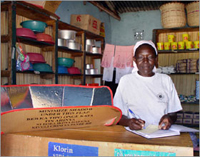
Better technology and user marketing attracts help from aid agencies. The use of technologies that combine solar power and energy efficiency is helping a growing segment of the more than 3 billion people in the developing world who burn traditional biomass fuels -- including wood and animal dung -- indoors for cooking and heating.
The current cooking practice, according to the World Health Organization, traps high levels of pollutants in the living area and causes 1.6 million premature deaths every year, mainly among women and children.
It also ravages trees, brush and other ground cover, promoting erosion and flooding in many areas that already are vulnerable to such occurrences.
"If this is the last tree in the whole country," Patricia McArdle told USINFO, referring to a photograph from Afghanistan, "and that lady has to cook dinner, she will cut that tree down and take it home. That's why we have to work with governments to implement these policies locally and promote the use of solar cooking."
But it is an integrated approach, added McArdle, with "solar cooking when the sun is shining, combined with energy-efficient cooking methods for nighttime and cloudy days." McArdle is a former State Department Foreign Service officer and now a board member with Solar Cookers International in California and Solar Household Energy in Washington.
By Cheryl Pellerin USINFO Staff Writer
COOKING WITH THE SUN[edit | edit source]
The three most common solar cookers are heat-trap boxes, curved concentrators (parabolics) and panel cookers. Hundreds of variations exist, instructions for making them are freely available on the Internet, and there are many manufacturers.
Box cookers, the most common around the world, cook at moderate to high temperatures and can heat several pots at once. There are several hundred thousand in India alone, according to the Solar Cookers International Web site.
Parabolic cookers focus sunlight into a single point and cook fast at high temperatures. They need frequent adjustment and supervision for safe operation. Several hundred thousand exist, mainly in China. They are especially useful for large-scale institutional cooking.
Panel cookers have elements of box and parabolic cookers. They are simple and relatively inexpensive to buy or produce. Solar Cookers International's "CooKit," designed by a physicist, is the most widely used combination cooker.
To keep food warm or extend cooking time, people can use an insulated basket. Solar cookers also can be used to dry foods, heat water and pasteurize water for drinking.
Combining solar cookers, insulated baskets and energy-efficient cook stoves "can reduce your use of fuel by about 85 percent," said McArdle, who has met with officials from a range of U.S. government agencies to seek funding for solar cooking projects worldwide.
Small nongovernmental organizations and nonprofits, and larger organizations like Rotary International and the German/international cooperation enterprise GTZ are helping spread the word about the technology.
ROCKET STOVE[edit | edit source]
Recently, the U.S. Environmental Protection Agency's (EPA) Partnership for Clean Indoor Air approved grants for five organizations, including Bolivia-based CEDESOL Foundation, which stands for Center for Development with Solar Energy.
The grant, CEDESOL Executive Director David Whitfield told USINFO, is for a scale-up project involving a uniquely designed wood-burning device called a rocket stove that "has been certified to be at least 42 percent efficient," does not pollute the environment, and gets about 95 percent of all the harmful gas particles out of the living space.
"This is significant, Whitfield said, "because many chimney stoves just get smoke out of the kitchen."
Thanks to the EPA funding, CEDESOL "will be able to purchase industrialization equipment and will receive consultations by research institutes to improve our process of producing our improved wood stove," Whitfield said. "Our goal is to deliver 20,000 stoves by mid-2009."
CEDESOL will build and sell the stoves to customers in Bolivia. GTZ is paying a $26 subsidy, he added, that helps make the stoves more affordable. GTZ is also part of a program to eradicate smoke in 100,000 homes in rural Bolivia.
A big part of making a success of the integrated cooking system -- efficient stoves, solar cookers and extended cooking devices -- is helping users develop the habit of using the new system.
First, Whitfield said, people must be able to buy the systems, "but unless there is some kind of marketing practice, the technology will not continue to exist."
McArdle agrees that there are issues with solar cookers.
"Technology transfer -- you've got to get the local leaders involved," she said. "In many cases, unless it's a real disaster situation, you want people to purchase [the equipment], so you have to have a microfinancing component."
But the benefits -- to households, businesses, governments, humanitarian and development organizations and environmental programs -- outweigh the issues.
"I see very positive growth in the industry," Whitfield said. "The people are more sophisticated, the equipment is better, and I believe it's time, from an ecological and an economical standpoint, that we start focusing on disseminating this type of technology."
More information about Solar Household Energy, Solar Cookers International and CEDESOL is available on the organizations' Web sites.
More information about the Partnership for Clean Indoor Air is available on the EPA Web site.
(USINFO is produced by the Bureau of International Information Programs, U.S. Department of State. Web site: http://web.archive.org/web/20171027230322/http://usinfo.state.gov/)